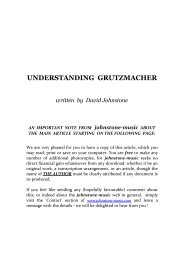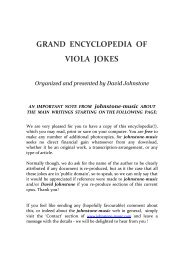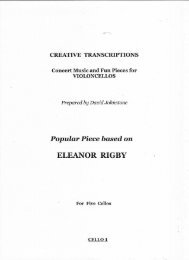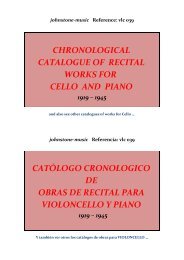vlc046-VOLKMANN Cello Concerto-j_m.pdf - Johnstone-music.com
vlc046-VOLKMANN Cello Concerto-j_m.pdf - Johnstone-music.com
vlc046-VOLKMANN Cello Concerto-j_m.pdf - Johnstone-music.com
Create successful ePaper yourself
Turn your PDF publications into a flip-book with our unique Google optimized e-Paper software.
THE GREAT CELLO<br />
CONCERTO<br />
OF ROBERT <strong>VOLKMANN</strong><br />
(1856-57)<br />
written by David <strong>Johnstone</strong><br />
escrito por David <strong>Johnstone</strong><br />
AN IMPORTANT NOTE FROM johnstone-<strong>music</strong> ABOUT<br />
THE MAIN ARTICLE STARTING ON THE FOLLOWING PAGE:<br />
We are very pleased for you to have a copy of this article, which you<br />
may read, print or save on your <strong>com</strong>puter. You are free to make any<br />
number of additional photocopies, for johnstone-<strong>music</strong> seeks no<br />
direct financial gain whatsoever from any download; whether it be an<br />
original work, a transcription-arrangement, or an article, though the<br />
name of THE AUTHOR must be clearly attributed if any document is<br />
re-produced.<br />
If you feel like sending any (hopefully favourable) <strong>com</strong>ment about<br />
this, or indeed about the johnstone-<strong>music</strong> web in general, simply<br />
visit the ‘Contact’ section of www.johnstone-<strong>music</strong>.<strong>com</strong> and leave a<br />
message with the details - we will be delighted to hear from you !<br />
johnstone-<strong>music</strong>
THE GREAT CELLO CONCERTO OF<br />
ROBERT <strong>VOLKMANN</strong> (1856-1857)<br />
Introduction:<br />
johnstone-<strong>music</strong><br />
By David <strong>Johnstone</strong><br />
I have to admit that when I was a full-time student in London, the name of Robert<br />
Volkmann did not mean anything to me, and this for someone who used to spend<br />
almost all of his grant on buying <strong>music</strong> scores! I believe that the first time that I<br />
read his name was in the excellent biography of David Popper by Stephen De’ak.<br />
De’ak spoke not only highly about the work itself, but on Popper’s genuine interest<br />
in bringing the <strong>com</strong>position before the general public. It made me curious; why<br />
dwell on this work and not other contemporary romantic works, such as the cello<br />
concertos by Molique or Raff? At a much later date, I did have the privilege of<br />
performing works of Volkmann, such as the String Serenades, and these<br />
experiences confirmed my initial beliefs that here was a <strong>com</strong>poser who has been<br />
treated unjustly during the second half of the twentieth century. This was a<br />
<strong>com</strong>poser who was so highly regarded in his day, almost an equal to Schumannn<br />
and Brahms; indeed some argue that Volkmann is that missing link between those<br />
two <strong>com</strong>posers, if you are looking at the progress of German romantic <strong>music</strong><br />
during the course of the century. What is important to take into consideration is<br />
that during his lifetime, not only was Volkmann’s <strong>music</strong> considered the equal of<br />
that of Schumann or Mendelssohn, but also was perceived to be more advanced. In<br />
that sense he may be that link that we do not know about between Schumann and<br />
Brahms.<br />
He was a ‘conservative’ <strong>com</strong>poser who was much more <strong>com</strong>fortable in the Brahms<br />
circle than the Wagner circle, though his relations were cordial with almost<br />
everyone. For example, it is said that when Liszt had a visitor staying with him, and<br />
for whom he wished to care especially well for, he played at his home a Volkmann<br />
piano trio with Joachim, the famous violinist, and the cellist Cossmann. His <strong>music</strong><br />
was held in the highest esteem not only by the famous, but also by the general<br />
<strong>music</strong>al public of his time. They were regularly mentioned in the same breath as<br />
with those of Beethoven. High praise indeed for a <strong>com</strong>poser whose works today are<br />
largely all out of print!
At the same time, he knew well personally Hans Von Bülow, Liszt, and the<br />
important <strong>music</strong> critic Eduard Hanslick. His <strong>music</strong> was very well received by the<br />
critics of the day, and works such as his second piano trio, Op. 5, and the first<br />
symphony were well-known and loved by both public and <strong>music</strong>ians. Given this, it<br />
is really surprising then that I did not know his name – the same, I guess, as many<br />
of you reading this article! However, history treats some <strong>com</strong>posers well and some<br />
badly. For example, although the name of Hindemith is still very much ‘alive’ with<br />
us as a historical name, in the 1930s and 1940s he was at the very forefront of<br />
current <strong>music</strong>al trends, along with Schoenberg and Stravinsky; yet he is not talked<br />
about in the same importance of the other two today in the world of the 21 st<br />
century. Another example – for me, Martinu is one of the greatest <strong>com</strong>posers of the<br />
twentieth century without doubt, yet performances of his works are be<strong>com</strong>ing<br />
scarcer as the years pass (he died in 1959). And so with Volkmann – after the First<br />
World War he quickly slipped down the ladder, perhaps not into total oblivion, but<br />
to be<strong>com</strong>e a rarity or novelty to be performed only now and again. I believe the<br />
principal reason for this was that … as a worthy <strong>com</strong>panion and colleague to<br />
Brahms, perhaps Volkmann found fewer answers to the call of modernity from the<br />
younger generation, than did Brahms or Dvorak. Ironically during the first decade<br />
of the 21 st century there have been more performances and recordings of his works<br />
than in the 50 previous years.<br />
So, before presenting his cello concerto, I firstly I wish to give a little idea of his life,<br />
though this biographical information is readily available from other sources.<br />
johnstone-<strong>music</strong>
Biographical Notes:<br />
Robert Volkmann was born in Lommatzsch, Germany, on April 6, 1815, and he<br />
was an almost exact contemporary of Wagner. Volkmann’s father was a church<br />
<strong>music</strong> director, and trained his son in <strong>music</strong> to prepare him as a possible<br />
successor. Thus the young Robert Volkmann learned to play not only the organ<br />
and the piano with his father, but simultaneously the violin and cello, and by<br />
age 12, he was playing the cello part in String Quartets by Haydn, Mozart and<br />
Beethoven. In 1832, Robert Volkmann entered the Freiberg Gymnasium and<br />
studied <strong>music</strong> with Anacker, going on to Leipzig in 1836 to study with C.F.<br />
Becker. There, in Leipzig, Volkmann met Robert Schumann, who encouraged<br />
him. They maintained contact with one another.<br />
When he finished his studies, he began working as voice teacher at a <strong>music</strong><br />
school in Prague. He did not stay there long, and in 1841, he moved to Budapest,<br />
where he was employed as a piano teacher and a reporter for the Allgemeine<br />
Wiener Musik-Zeitung. Although <strong>com</strong>posing at this time his <strong>music</strong> had no<br />
outlets. Then, during 1852, his Piano Trio in B minor caught the attention of<br />
Franz Liszt and Hans von Bülow, who recognized its quality, and who proceeded<br />
to play it a number of times all over Europe. In 1854, Volkmann moved to<br />
Vienna, but returned to Budapest in 1858; it is cited that he missed the city<br />
during his four years in Vienna. In Budapest he became a good friend of the<br />
great cellist David Popper, and Popper was to promote Volkmann’s cello<br />
concerto more than anyone. Volkmann’s <strong>com</strong>positional talent was also highly<br />
recognized by the publisher Gustav Heckenast, who in 1857 bought the rights to<br />
publish all Volkmann's works in exchange for regular in<strong>com</strong>e regardless of sales.<br />
Volkmann was therefore joyously able to fully dedicate himself to <strong>com</strong>position<br />
for over a decade, until Heckenast had to close down his Budapest publishing<br />
house in the early 1870s.<br />
While visiting Wien in 1864, Volkmann became well-acquainted with Johannes<br />
Brahms, and they became close friends. In letters to each other, they started by<br />
"lieber Freund" ("dear friend").<br />
In the 1870s Volkmann began winding down on his life, <strong>com</strong>posing very little.<br />
From 1875 until his death, Volkmann was professor of harmony and<br />
counterpoint at the National Academy of Music in Budapest, where Franz Liszt<br />
was the director. Volkmann died on October 30, 1883.<br />
johnstone-<strong>music</strong>
Analysis of the <strong>Cello</strong> <strong>Concerto</strong>:<br />
Written 6 or 7 years after the Schumann work, the A Minor <strong>Concerto</strong> of Volkmann<br />
was one of the most remarkable concertos of its time. At first the critics were<br />
divided; some could not understand a concerto cast in a single long movement,<br />
with operatic vocal effects, and an unusually gentle yet somewhat eerie final page,<br />
whilst others enthusiastically warmed to it. However, it seems that cellists took this<br />
work on board almost without reservations. For example, it was probably the<br />
favourite concerto of all for Popper, and maybe the concerto that he played the<br />
most in public. Certainly, between 1860 and 1890, it was the most famous and<br />
highly-rated cello concerto in existence, surpassing those of even Haydn and<br />
Schumann; only thereafter (in the 1890s) did the A minor concertos of both<br />
Schumann and Saint-Saens begin to <strong>com</strong>e to the fore. However, it was the new<br />
concertos by the more ‘classically’ inclined romantics (as of course Volkmann was<br />
himself) that were to supersede this concerto in the first third of the twentieth<br />
century– such as Boellmann (Symphonic Variations), Tchaikovsky (Rococo<br />
Variations – 1876), Lalo (<strong>Concerto</strong> – 1880), Brahms (Double <strong>Concerto</strong> – 1887),<br />
Dvorak (<strong>Concerto</strong> – 1895), Strauss (Don Quixote – 1897), and to a lesser extent<br />
those by Enescu (Sinfonia Concertante – 1901) and Dohnanyi (Konzertstucke –<br />
1903/04). Ironically, some of these works are themselves now little-programmed.<br />
However, the public resurrection of Volkmann’s concerto is long overdue; even<br />
though it has been played and recorded in more recent years (a recording by<br />
Thomas Blees is a worthy example, showing an excellent ‘blend’ of soloist and<br />
orchestra). There is also an abridged version of the work which I will later refer to,<br />
with numerous passages cut out by the then renowned German professor Hugo<br />
Becker, but this may well have done more harm than good to Volkmann’s cause<br />
within Germany, between the two world wars. To his credit, however, Becker’s<br />
cadenza is both interesting and challenging.<br />
In earlier times, this concerto was difficult to <strong>com</strong>prehend and to analyze - it is<br />
actually written in sonata form, in one great elongated movement (though<br />
Volkmann himself often tricked his <strong>music</strong>al colleagues into thinking that it<br />
contained three movements within one, perhaps fearing they would ‘frown’ upon<br />
him if he revealed that he had daringly ‘modernized’ the concept of the cello<br />
concerto!). Structure apart, the work reveals a careful and meticulous dialogue of<br />
soloist and orchestra which even surpasses that found in the Schumann concerto.<br />
The exposition contains three different subject groups in the exposition, later<br />
allowing numerous opportunities for ‘juxtapositions’ within a well-knit and wellcrafted<br />
development section. The first theme, deliberately angular and academic,<br />
somewhat resembles the Schumann concerto opening in that it is in A minor and<br />
pivots on the tonic (‘A’) and the 5 th (‘E’):<br />
johnstone-<strong>music</strong>
Even during this first theme, the virtuosity be<strong>com</strong>es apparent – Volkmann’s high<br />
knowledge of cello playing is very apparent:<br />
The ‘second’ theme, still in A minor, is far more sprightly, and also enters<br />
immediately with virtuosic play:<br />
johnstone-<strong>music</strong>
The work is enormously virtuosic and coaxes substantial technique out from the<br />
soloist, such as passages full of sixths, thirds and octaves, enormous leaps across<br />
the strings and chromatic runs racing through all the positions.<br />
By contrast, the third theme is really what we expect from the normal ‘second’<br />
subject – tender, cantabile, gentle, though not without its own technical difficulty:<br />
Furthermore, this development starts with opera-influenced recitative passages,<br />
and proceeds with it during a whole mini-section, and which (for the cello) was<br />
certainly a novelty at this time:<br />
johnstone-<strong>music</strong>
The harmonically sublime transition back to the recapitulation, decorated by cello<br />
arpeggios, is of the highest <strong>music</strong>al order (close even to the most mature Brahms).<br />
johnstone-<strong>music</strong>
There is a glorious opportunity for a well-developed cadenza towards the close.<br />
Volkmann himself wrote some four different cadenzas for the work, and there were<br />
also at least two other regular cadenzas known and used – of which perhaps that by<br />
Popper was the most highly regarded (curiously rated higher than Volkmann’s own<br />
cadenzas!). David <strong>Johnstone</strong> has also written a cadenza for this work (in ‘A Manual<br />
of Cadenzas and Cadences for <strong>Cello</strong>’, published by Creighton’s Collection) and his<br />
is an attempt at a faithful re-working of some of the material as presented by<br />
Volkmann initially, with the inclusion of a small quotation of the ‘tremolo’ part<br />
from the Becker cadenza. It is altogether quite a substantial creation, the need here<br />
being for a fully romantic outpouring of real substance from the soloist, before<br />
arriving at a more relaxed and introverted coda. Perhaps ‘eerie’ would be a better<br />
description than ‘relaxed’…<br />
In summing up so far the work structurally and technically, one can assert with<br />
confidence that this is a most interesting work that certainly deserves more regular<br />
performances.<br />
johnstone-<strong>music</strong>
Later Considerations<br />
The first printed score of the concerto was only published in 1905 by Schott,<br />
who had bought the original rights from the Hungarian <strong>com</strong>pany Heckenast.<br />
But this was already a shortened version made by the cellist Hugo Becker.<br />
Such things were <strong>com</strong>mon at that time – learned <strong>music</strong>ians sought to<br />
genuinely „improve‟ a work with their tinkering. One only has to remember<br />
the number of versions of Bruckner symphonies formerly available, and<br />
many of them were not authorized by the <strong>com</strong>poser himself. The Boccherini<br />
<strong>Cello</strong> <strong>Concerto</strong> in Bb Major (reworked by Grützmacher) and the Rococo<br />
Variations of Tchaikovsky (reworked by Fitzenhagen) were but two polemic<br />
problems for cellists in the following century, even if today the „two‟<br />
versions can live alongside one and another. Therefore the orchestral parts<br />
and the solo part were soon adapted to Becker‟s score.<br />
However, in 1942, Schott published a “new” version that they endeavoured<br />
to sell by stating on the cover that it was a “free adaption” by the cellist<br />
Enrico Mainardi. I do not possess this score, but I understand that it was<br />
very much an improvement in that it recuperated some of the original<br />
material by Volkmann that was lost under Becker‟s „butchering‟. This<br />
“improved” version was played in Germany and across the world and even<br />
recorded. However, recently, and due to the painstaking work of the<br />
astronomer and Volkmann expert Dr Daniel Christlein we now have, once<br />
more, the „original‟ work as Volkmann wished, with some three minutes of<br />
extra <strong>music</strong> as <strong>com</strong>pared to the revised Schott score, and some minutes<br />
extra again from the Becker „truncated‟ version. Dr Christlein also<br />
reconstructed the orchestral parts we now have.<br />
One more anecdote: David Popper (1843–1911), who was equally at home<br />
in Prague, Vienna and Budapest, and loved above all the two important cello<br />
concertos that dated from his own youth: those of Schumann (published in<br />
1854) and Volkmann (published in 1858). Later, Popper became a highly<br />
successful teacher and produced some important cellists. One of his<br />
greatest pupils was the Hungarian Arnold Földesy (1882–1940), who was<br />
appointed solo cellist of the Berlin Philharmonic in 1915. Under the<br />
conductor Nikisch and his successor Wilhelm Furtwängler, Földesy played<br />
most of the important cello concertos with the orchestra. In 1924, he left<br />
the orchestra to pursue a solo career. In that same year, Földesy recorded<br />
the Volkmann concerto op. 33 (amongst other works) on six records of the<br />
VOX <strong>com</strong>pany. It was the world premiere recording of the work.<br />
johnstone-<strong>music</strong>
Volkmann’s other Works<br />
Most of Volkmann's <strong>com</strong>positions are either for solo piano or ensembles<br />
including piano. It was his Piano Trio in B minor that first brought him renown.<br />
During his 4-year stay in Vienna, Volkmann <strong>com</strong>posed his Variations on a<br />
Theme of Handel, String Quartets No. 3 and No. 4 in E minor, and the <strong>Cello</strong><br />
<strong>Concerto</strong> in A minor.<br />
Almost all of Volkmann's orchestral works date to the time of his association<br />
with Heckenast. These include an Overture for William Shakespeare’s play<br />
"Richard III", an Overture in C major, the Symphony No. 1 in D minor (which<br />
was a major success when premiered in Moscow) and the Symphony No. 2 in B<br />
flat major, dedicated to the Russian Musical Society.<br />
Volkmann believed that a <strong>com</strong>poser should be satisfied with creating in the<br />
listeners' minds the desired mood and impression by purely <strong>music</strong>al means; if<br />
the contours of the action and the plot are recognized by the listener, this should<br />
be considered a happy coincidence.<br />
When Volkmann's Symphony No. 1 was played on a Canadian Broadcasting<br />
Corporation Radio Two request show, in early 1998, it was remarked that "It<br />
sounds almost like a forgotten work by Brahms... almost."<br />
Unlike the serious first symphony, the Symphony No. 2 is rather more cheerful.<br />
Robert Volkmann's grandson, Hans Volkmann, remarks: "After Haydn, naïve<br />
cheerfulness was only extremely rarely chosen as the basic mood of an entire<br />
Symphony."<br />
Given that his first piano trio largely helped to ‘put him on the <strong>music</strong>al map’,<br />
here are some words about the work:<br />
The Piano Trio No.1 was <strong>com</strong>posed in 1842-3 during his first sojourn in Pest,<br />
but not published until he moved to Vienna in 1852. The trio begins with a<br />
stately Adagio introduction which builds slowly in tempo and emotion and<br />
seamlessly leads to the main movement Quasi Andante. The heavily accented<br />
first theme is reminiscent of Beethoven while the second theme is lighter,<br />
almost playful. The second movement, Allegretto, is a scherzo and again shows<br />
the influence of Beethoven. The slow movement, Andante, is for the most part a<br />
calm pastorale, straight forward and simple, although the middle section<br />
provides a clever contrast in both tempo and emotion without be<strong>com</strong>ing overly<br />
dramatic or stormy. The finale, Allegro con fuoco, is clearly the show piece of<br />
the trio. It contains three excellent themes, all of which provide excellent<br />
contrast. It begins with a highly dramatic and rhythmically swaying subject<br />
which suddenly, without any development, gives way to an exciting gypsy<br />
theme. Just imagine - Brahms himself later borrowed this technique many<br />
times !!<br />
johnstone-<strong>music</strong>
Volkmann’s three String orchestral Serenades are highly romantic and cheerful<br />
works. Although the <strong>com</strong>poser himself labeled them ‘modest’, perhaps for their<br />
playable character, they were very much loved by performers and general public<br />
(perhaps by this very playable conviction that they hold). Having said that, they<br />
are not quite so simple, structurally speaking, as they might sound, and the<br />
high-class craftsmanship is obvious at all moments. The lighter orchestration of<br />
using only strings heralds back to the original ideals of the serenade during<br />
Mozart’s time. Volkmann was probably also influenced by the two Brahms<br />
serenades of 1858 and 1860, but Volkmann’s became far more popular than<br />
those of his friend during the second half of the nineteenth century! The first<br />
two serenades of (in C Major and F Major) mix symphonic concept with dance<br />
and march movements, but the third serenade in D Minor not only features a<br />
cello soloist (which features the orchestral principal cellist, and not usually an<br />
‘invited’ soloist) but is of an almost continuous movement whilst made up of<br />
contrasting sections.<br />
johnstone-<strong>music</strong>
List of Principal Works (+ dates where possible)<br />
Orchestral Works<br />
Symphony No. 1 in D minor, Opus 49 (1862/63)<br />
Symphony No. 2 in B-flat major, Opus 53 (1864/65)<br />
Serenade No. 1 in C major, for strings, Opus 62 (1869)<br />
Serenade No. 2 in F major, for strings, Opus 63 (1869)<br />
Serenade No. 3 in D minor, for cello and strings, Opus 69 (1870)<br />
Overtures<br />
<strong>Cello</strong> <strong>Concerto</strong> in A minor, Opus 33 (1853-55)<br />
Konzertstück in C major, for piano and orchestra, Opus 42 (1861)<br />
Chamber Music<br />
Vocal Music<br />
Piano Music<br />
Piano Trio No. 1 in F major, Opus 3 (1842/43)<br />
Piano Trio No. 2 in B minor, Opus 5 (1850)<br />
String Quartet No. 1 in A minor, Opus 9 (1847/48)<br />
String Quartet No. 2 in G minor, Opus 14 (1846)<br />
String Quartet No. 3 in G major, Opus 34 (1856/57)<br />
String Quartet No. 4 in E minor, Opus 35 (1857)<br />
String Quartet No. 5 in F minor, Opus 37 (1858)<br />
String Quartet No. 6 in E-flat major, Opus 43 (1861)<br />
5 Pieces for <strong>Cello</strong> and Piano, Op.21 (arrangements of Leopold Grützmacher)<br />
many Lieder<br />
Sonata in C minor, Opus 12<br />
Variations on a Theme of Händel, Opus 26<br />
Lieder der Großmutter, Opus 27<br />
Hungarian Sketches, Opus 24 (4hdg., 1861)<br />
3 Marches, Opus 40 (4hdg., 1859)<br />
Sonatina in G major, Opus 57 (4hdg., 1868)<br />
Little Pieces for 2 bzw. 4 Hände<br />
johnstone-<strong>music</strong>
VISIT!<br />
johnstone-<strong>music</strong> is a most interesting and very active web page of the British<br />
born, now Spanish-based <strong>com</strong>poser, arranger and cellist DAVID JOHNSTONE –<br />
a Web page very highly regarded by English-speaking <strong>music</strong>ians of many nations.<br />
- Almost everything is also offered in Spanish -<br />
What can the web page www.johnstone-<strong>music</strong>.<strong>com</strong> offer you?<br />
FREE downloads of many original and interesting <strong>com</strong>positions – these<br />
scores, not <strong>com</strong>mercially published, include pieces for bowed string instruments<br />
(violin, viola, cello and double bass), woodwind (flute, oboe, clarinet, bassoon),<br />
brass, piano and accordion. Chamber <strong>music</strong> is well represented, and not just by<br />
duos, trios or quartets, but also for larger groupings right up to pieces for string<br />
orchestra (suitable in scope both for youth orchestras and professionals).<br />
FREE downloads of transcriptions for Cellists (classical and popular <strong>music</strong>)<br />
with solos, and pieces for ensembles of varying sizes from duos up to cello<br />
orchestras. A substantial section …<br />
A colourful PDF catalogue of all the many important published works (from the<br />
editor CREIGHTON’S COLLECTION) is also available from the home page of<br />
johnstone-<strong>music</strong>, as a FREE DOWNLOAD.<br />
FREE downloads of ARTICLES – in two main sections; one of general<br />
<strong>music</strong>al themes, and the other relating specifically to matters of the<br />
Violoncello – written by a wide range of professional <strong>music</strong>ians. Also a<br />
Directory/Library with information about Famous Historical Cellists<br />
(some 600 cellists are included).<br />
Biographies, performances, audio extracts (some 50 or so), images, links,<br />
recordings, chamber <strong>music</strong> formations, current projects, <strong>com</strong>position list,<br />
sales of CDs and published sheet <strong>music</strong> etc. –<br />
Interactive sections: Diary, News, Contact, Suggestions, a quick survey,<br />
<strong>com</strong>ments etc. Also a section of useful tools for <strong>music</strong>ians. Leave your<br />
opinions, and receive free publicity of any performance of a work or<br />
arrangement of David <strong>Johnstone</strong>, with links to your web page (or that of<br />
the organizers), if desired.<br />
Worthwhile exploring !<br />
www.johnstone-<strong>music</strong>.<strong>com</strong><br />
johnstone-<strong>music</strong>
¡VISITA!<br />
johnstone-<strong>music</strong> es una interesante y muy activa página Web del<br />
violoncellista, <strong>com</strong>positor y arreglista DAVID JOHNSTONE – un sitio Web<br />
altamente valorada entre los músicos hispano-parlantes de muchos países.<br />
- Toda la información está también ofrecida en inglés -<br />
¿Qué te puede ofrecer la web www.j-<strong>music</strong>.es ?<br />
Hay muchas partituras ofrecidas para DESCARGA GRATUITA - estas<br />
partituras, obras no publicadas por una editorial, incluyen piezas para los<br />
instrumentos de cuerdas (violín, viola, violoncello y contrabajo), vientos (flauta,<br />
oboe, clarinete, fagot), metales, piano y acordeón. La música de cámara está bien<br />
presente, y no solo representada por dúos, tríos y cuartetos, sino también por<br />
grupos más grandes hasta obras para orquesta de cuerdas (adecuadas ambas para<br />
orquestas de jóvenes y profesionales).<br />
Adicionalmente hay una gran sección de descargas gratuitas de<br />
transcripciones para violoncellistas (música clásica y popular), con solos, y<br />
piezas para los grupos de violoncellos desde dúos hasta orquestas de<br />
violoncellos.<br />
Al mismo tiempo, un buen número de las obras más importantes de <strong>Johnstone</strong> están<br />
publicadas por ‘Creighton’s Collection’ y para ver estás un PDF especial está<br />
disponible en la página principal, también de LIBRE DESCARGA.<br />
Dos secciones inusuales de artículos (también con descargas gratuitas)<br />
sobre temas <strong>music</strong>ales generales, y del mundo del violoncello, escritos por<br />
un amplio abanico de músicos profesionales, los cuales son interesantes<br />
colaboradores. También un Directorio/Biblioteca con información sobre<br />
Violoncellistas Históricos Famosos (unos 600 cellistas presentes).<br />
Los contenidos ‘normales’ – biografías, actuaciones, extractos de audio<br />
(unos 50), imágenes, enlaces, grabaciones, formaciones de música de<br />
cámara, proyectos actuales, lista de <strong>com</strong>posiciones, ventas de CDs etc. -<br />
La Web se <strong>com</strong>pleta con secciones interactivas: Agenda, Noticias,<br />
Sugerencias, Encuesta breve, <strong>com</strong>entarios etc. También una sección de<br />
herramientas útiles para músicos. Dejad vuestras opiniones, y añadir<br />
publicidad gratuita de cualquier actuación vuestra de una obra o arreglo de<br />
David <strong>Johnstone</strong>, con enlaces a vuestras Webs, o la de los organizadores, si<br />
lo deseáis.<br />
¡¡ Merece la pena investigar !!<br />
www.j-<strong>music</strong>.es<br />
johnstone-<strong>music</strong>
johnstone-<strong>music</strong>









